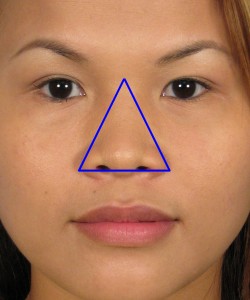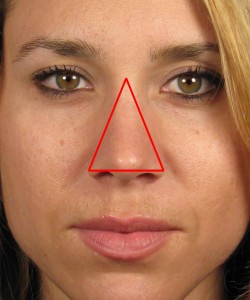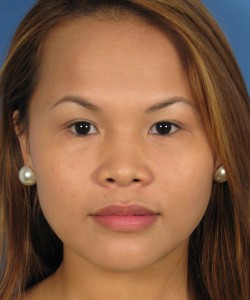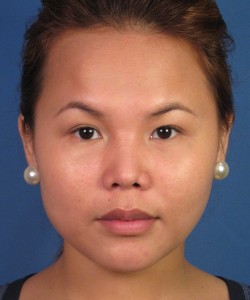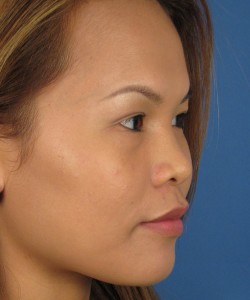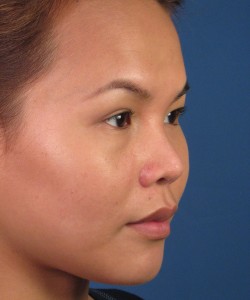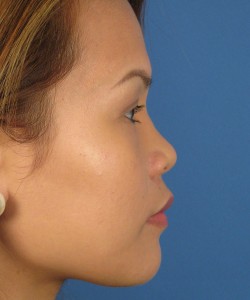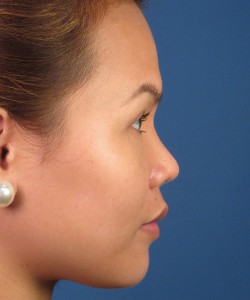Asian rhinoplasty is a form of cosmetic nose reshaping that is very specific to this ethnic group. In fact, Asian rhinoplasty surgery is so different than other types of nose reshaping that a distinct esthetic ideal is often used in the surgical planning. The following rhinoplasty tutorial chapter focuses on the nuances of performing Asian rhinoplasty and hopefully provides an educational foundation for those considering possible Asian nose reshaping surgery.
What Is The Goal in Asian Rhinoplasty Surgery?
So what are we striving to achieve in Asian rhinoplasty? In summary, the goal of Asian rhinoplasty is to create a nose that does not look like it belongs on a Caucasian face. Well performed cosmetic Asian nose reshaping is able to create a look that is ethnically consistent with the Asian face and does not appear as if it was surgically done.
It should be pointed out that a reasonable number of Asian rhinoplasty patients request elevation of their bridge height in order to better accommodate eyeglasses. This is an issue that is directly related to a deficiency in their bridge height at the upper end of the dorsum where eyeglasses normally rest. In the Asian nose, eyeglasses can tend to slip down on the bridge since there is a relative lack of support to hold the glasses up. By elevating, or augmenting, the nasal bridge in the Asian nose, eyeglasses can potentially fit more appropriately.
What Makes Asian Noses Different?
There are a variety of differences between an Asian and Caucasian nose with many of these distinctions highlighted below.
Overall Shape
One of the key distinctions on first glance of the Asian nose is that it should maintain an overall more triangular shape. In the adjacent photo diagrams, you can see that the Asian nose on the left has more of a triangular outline versus the Caucasian nose. This more triangular shape to the Asian nose is a result of several factors that will be discussed in more detail below. It is real important when performing Asian rhinoplasty that your nose reshaping specialist be cognizant of this overall shape and careful to maintain this key ethnic feature.
Bridge Height
In many Asian noses, there is a deficiency in bridge height, which creates a wider, flatter looking nose. The goal in Asian rhinoplasty is to reshape the bridge so there is improved shadowing along the dorsum. The goal should not be to replicate the bridge height seen in a Caucasian nose. The aim in Asian rhinoplasty bridge reshaping is to elevate the dorsum an appropriate amount without distracting from the ethnic appearance. If your surgeon elevates the bridge height as if it were a Caucasian nose, they will risk making the nose look more Romanesque. Therefore, bridge augmentation, or elevation, in Asian rhinoplasty has to be done in a more conservative fashion to preserve the ethnic features of the face.
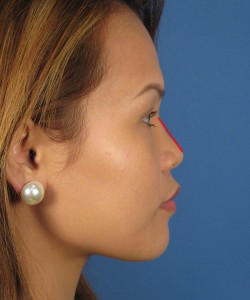 When augmenting the nasal bridge in Asian rhinoplasty, you typically need a fairly long piece of material (cartilage or implant) to span the desired distance of the bridge to be elevated. In the adjacent photo diagram, you can see this indicated by the red line along the bridge. Using a single, continuous graft or implant will maximize chances of a smoother bridge contour while minimizing chances of postoperative contour irregularities. You can imagine trying to create one long graft by sewing together, for instance, several smaller pieces of septal or ear cartilage. The chances of each individual piece of cartilage absorbing prematurely is moderately high. Therefore, the likelihood that you will be able to create one single, symmetrical, smooth graft that maintains the desired size and shape is very low. Therefore, choice of material is critical when deciding on how to augment the Asian nasal bridge.
When augmenting the nasal bridge in Asian rhinoplasty, you typically need a fairly long piece of material (cartilage or implant) to span the desired distance of the bridge to be elevated. In the adjacent photo diagram, you can see this indicated by the red line along the bridge. Using a single, continuous graft or implant will maximize chances of a smoother bridge contour while minimizing chances of postoperative contour irregularities. You can imagine trying to create one long graft by sewing together, for instance, several smaller pieces of septal or ear cartilage. The chances of each individual piece of cartilage absorbing prematurely is moderately high. Therefore, the likelihood that you will be able to create one single, symmetrical, smooth graft that maintains the desired size and shape is very low. Therefore, choice of material is critical when deciding on how to augment the Asian nasal bridge.
There are several options available that satisfy this requirement to augment the bridge in Asian rhinoplasty. These include using (1) the patient’s own cartilage, (2) tissue banked cartilage, (3) diced cartilage fascia, and (4) a variety of nasal implants.
Patient’s Own Cartilage (Autogenous Cartilage)
It is always the preferred choice to use the patient’s own natural cartilage when it comes to augmenting the nasal bridge. When using the patient’s own cartilage, it is referred to as autogenous cartilage grafting. In Asian noses, however, there is a relative lack of cartilage available for this purpose. In the average Caucasian nose, the septum has sufficient amounts of cartilage to use for grafting the bridge. Unfortunately, in a great majority of Asian rhinoplasty patients their septum has an inadequate amount of septal cartilage to use for building the bridge up. Even if there is a sufficient amount, the cartilage is often times too thin to be work well for bridge augmentation. Although ear cartilage grafting to the nasal bridge is a viable option in some rhinoplasty patients, Asian noses often times need a significantly greater amount to achieve the desired effect. So this usually leaves costal (rib) cartilage as the only good choice for autogenous bridge augmentation in the Asian nose. Costal cartilage grafting allows the rhinoplasty surgeon to harvest a sufficient amount of resilient cartilage that can be used effectively to elevate the bridge height to the desired level. One downside to performing autogenous costal cartilage grafting in the Asian nose is the fact that rib cartilage harvesting can add more pain to the recovery process (since there is a second operative site besides the nose) while also extending the amount of time it takes to complete the surgery. Despite this, most nose specialists will agree that costal cartilage grafting in the Asian patient is considered well worth the additional time and effort to achieve the best possible rhinoplasty result.
Tissue Banked Cartilage
An alternative to using the patient’s own rib cartilage is obtaining rib cartilage from a tissue bank. This is also referred to as irradiated cadaveric rib cartilage grafting since the cartilage is treated with gamma radiation prior to use. This process of irradiating the cartilage is done to essentially sterilize the graft before being used in surgery. This is a nice option for Asian rhinoplasty patients who simply do not want to have their own rib cartilage taken. With tissue banked cartilage, a sufficiently large size of rib cartilage is obtained from the tissue bank and used in a similar manner as autogenous rib cartilage would be for bridge augmentation. The tissue banked cartilage is reshaped in a similar manner as would be done with autogenous rib and placed in the same fashion as would be done with the autogenous cartilage. A huge advantage of using tissue banked cartilage is not having to undergo a surgical procedure involving the chest wall. As a result, there is no painful recovery in terms of the cartilage donor site. One potential disadvantage of the tissue banked cartilage is the rare and remote possibility of developing an infection from the cartilage graft. Thankfully, federal law requires the strictest screening guidelines for cadaveric rib cartilage use and the irradiation process to treat the graft helps significantly reduce the possibility of having an adverse tissue reaction. Furthermore, surgical studies have proven the long-term safety and efficacy of using tissue banked rib cartilage grafting in cosmetic nose reshaping.
Diced Cartilage Fascia (DCF)
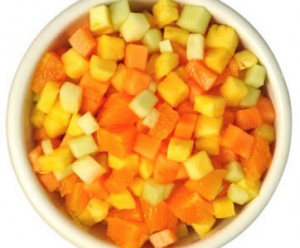 Diced cartilage fascia, or DCF, grafting is another method for augmenting the Asian bridge in rhinoplasty. Like autogenous and tissue banked costal cartilage grafting, you can create a fairly smooth, continuous graft using DCF technique. This specialized method offered by rhinoplasty specialists involves a combination of cartilage and temporal fascia grafting. The temporal fascia refers to a smooth, thin sheet of soft tissue that can be taken from under the scalp, just above the ear. The cartilage source can be the septum and/or ear in Asian rhinoplasty patients. However, when using this type of cartilage it has to be wrapped in a sleeve of temporal fascia in order to create a single graft for bridge augmentation. The cartilage is first diced into hundreds of small pieces. This is analogous to dicing larger pieces of fruit into much smaller individual pieces (see adjacent photo). The diced pieces of cartilage are then wrapped in a sleeve of temporal fascia so that you have effectively created one long, continuous piece for grafting.
Diced cartilage fascia, or DCF, grafting is another method for augmenting the Asian bridge in rhinoplasty. Like autogenous and tissue banked costal cartilage grafting, you can create a fairly smooth, continuous graft using DCF technique. This specialized method offered by rhinoplasty specialists involves a combination of cartilage and temporal fascia grafting. The temporal fascia refers to a smooth, thin sheet of soft tissue that can be taken from under the scalp, just above the ear. The cartilage source can be the septum and/or ear in Asian rhinoplasty patients. However, when using this type of cartilage it has to be wrapped in a sleeve of temporal fascia in order to create a single graft for bridge augmentation. The cartilage is first diced into hundreds of small pieces. This is analogous to dicing larger pieces of fruit into much smaller individual pieces (see adjacent photo). The diced pieces of cartilage are then wrapped in a sleeve of temporal fascia so that you have effectively created one long, continuous piece for grafting. 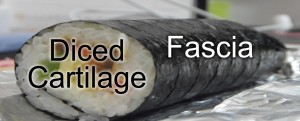 Keeping with the food analogies, this is much like a seaweed roll as shown in the adjacent photo diagram. The diced cartilage is like the center of the roll and the temporal fascia is akin to the seaweed sleeve. Depending on how high you wish to augment the nasal bridge, you can add more or less diced cartilage into the DCF graft. The entire piece of DCF is then placed over the nasal bridge to elevate the height. With time, the DCF graft gets incorporated into the nose by natural ingrowth of the surrounding tissues. In many studies, the DCF graft has been shown to be an equivalent method to costal cartilage grafting for augmentation of the nasal bridge.
Keeping with the food analogies, this is much like a seaweed roll as shown in the adjacent photo diagram. The diced cartilage is like the center of the roll and the temporal fascia is akin to the seaweed sleeve. Depending on how high you wish to augment the nasal bridge, you can add more or less diced cartilage into the DCF graft. The entire piece of DCF is then placed over the nasal bridge to elevate the height. With time, the DCF graft gets incorporated into the nose by natural ingrowth of the surrounding tissues. In many studies, the DCF graft has been shown to be an equivalent method to costal cartilage grafting for augmentation of the nasal bridge.
Nasal Implants
Nasal implants refer to one of many biological materials that can be used to augment the Asian nasal bridge. Some implants are more popular than others amongst rhinoplasty surgeons. One of the huge benefits of using an implant is not having to obtain cartilage from another source. Nasal implants are preformed and in plentiful supply. Plus, they can be customized on the operating room table and readily used in the midst of the rhinoplasty procedure. Unfortunately, one of the downsides of nasal implants is the fact they can be rejected or get infected due to the body reacting to the implant as a foreign object. This is not a concern at all when using autogenous cartilage grafts. Fortunately, this risk with nasal implants is quite low when they are placed by an experienced rhinoplasty specialist in the appropriate patient. This usually means an ethnic rhinoplasty patient who has fairly thick skin overlying the bridge, which can provide a significant soft tissue buffer that reduces chances of rejection and infection. Asian noses tend to fit this description and, therefore, are a reasonable choice when considering nasal implants. Among the various nasal implants, each has its advantages and disadvantages. Goretex happens to be one of the more viable options when performing Asian rhinoplasty. The Goretex can be individualized in terms of height and width to achieve the desired level of augmentation. With healing, the Goretex can also become fixated in position, which minimizes chances of postoperative movement. The same cannot be said for other nasal implants like silicone rubber. This is a popular nasal implant, especially in Asia. But, unfortunately, the implant commonly becomes displaced and moves after surgery because it never really gets fixated in position. Another problem with silicone nasal implants is they can potentially be seen as a translucent area inside of the nose when there is light shining across the face. Other nasal implants, such as Porex, are even less desirable for Asian bridge augmentation. This is primarily because the Porex implants can stimulate an overly aggressive tissue response by the body and become excessively hard in some patients.
Bridge Width
The width of the nasal bridge in Asian rhinoplasty patients is more often a function of the bridge height mentioned above. Meaning, the nasal bridge can be made to look more narrow by elevating the bridge height to a sufficient degree. The higher the bridge, the more shadowing effect will be seen on each side and the more refined the nose will appear. In some cases, however, the bridge can also look excessively wide or flat because of the underlying nasal bones. This type of anatomical issue is much less frequently encountered when compared with Caucasian rhinoplasty patients. In these rare cases of Asian rhinoplasty where the nasal bones are too wide, they have to be narrowed during surgery in addition to augmenting the nasal bridge. Thankfully, this is much more the exception than the rule in Asian rhinoplasty.
Tip Shape
The average Asian nose has a tip that naturally is more rounded than a Caucasian nose. This usually results from Asian noses having much thicker skin in combination with inherently thinner, weaker underlying cartilage. The thicker nasal skin does not show refinement as easily as thinner nasal skin. And thinner, weaker tip cartilage is also less likely to show proper definition. When these two issues coexist in the same nose, the end result is a more rounded, less refined appearing nasal tip. Other common issues with the Asian nasal tip include a lack of projection (how far the nose sticks out from the face) and under-rotation of the tip.
Traditional rhinoplasty techniques used to refine the nasal tip, such as suture reshaping, are simply not as effective in the Asian rhinoplasty patient. Instead, most Asian rhinoplasty patients require some form of cartilage grafting to the tip in order to realize any significant improvement in definition. This includes placement of shield-shaped tip grafts and alar rim grafts where appropriate. In some patients who require lengthening of the nasal tip, this might even necessitate more complex grafting of the nose. And even then, the goal should be to provide improved tip refinement without appearing too narrow or angulated. Preservation of some roundness in the nasal tip is one of the keys to achieving successful results in the Asian rhinoplasty patient population.
Base Width
One of the more common maneuvers in Asian rhinoplasty is alteration of the nasal base width. In a good majority of Asian rhinoplasty patients, the nasal base is excessively wide and/or flared. A wide base refers to the actual linear measurement of the bottom of the nose being excessive. Flaring is in reference to an excessively curved nostril contour outside of the attachment of the base. In many Asian rhinoplasty patients one or both of these issues need to be addressed to refine the nose. Some of this is improved with projection of the nasal tip outward from the face. It should be emphasized, however, that the goal in Asian rhinoplasty is to maintain some width at the nasal to preserve the desired overall triangular shape to the nose. Overly aggressive base reduction in the Asian nose can unfortunately be quite obvious leading to a nostril base that literally looks like it was cut and pasted.
Asian Rhinoplasty Photo Examples
The following is a great example of Asian rhinoplasty in this female patient from San Diego, CA who desired refinement of her nose. She exemplifies many of the issues discussed above with regard to cosmetic reshaping of the Asian nose. For instance, you can see that her bridge height was elevated during the rhinoplasty procedure, but was done without creating an excessively high bridge as seen on her profile view. She now has improved shadowing with a more narrow looking bridge as seen from the front, yet still looks like she has an Asian nose. In the tip area, you can appreciate more refinement and definition of her nasal tip, but it still appears slightly rounded as an Asian nose should look. And you can see that her nasal base was also narrowed during the rhinoplasty, however, not excessively so. Overall, her nose still very much possesses the key features of an Asian nose, but has been refined sufficiently to address those issues that were bothering her.
Additional Asian Rhinoplasty Examples
To learn more about Asian rhinoplasty surgery, click here to see additional other examples of nose job surgery in Asian patients.

